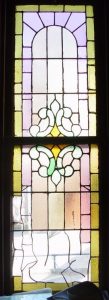Steps to a successful repair or restoration
Stained glass windows require periodic care to ensure their longevity, if you consider that a restoration could extend the life of your stained glass window for another 100 years, the investment is more cost effective than most major building repairs. Stained glass windows usually deteriorates slowly at first, but damage can rapidly accelerate as vital components begin to break down, it is important to take a pro-active approach to conservation, restoration and maintenance to avoid further damage to the stained glass panels. It all starts with a on-site inspection and consultation of your stained glass windows.
Whether it is a small repair or a complete restoration I use modern techniques combined with ancient traditions to meticulously restore your stained glass to its original beauty.
Some stained glass windows that are still structurally intact, but has small damaged areas such as broken or cracked glass can sometimes be repaired on-site without the need of removing the window.
Over time, usually between 50-100 years the lead came (the metal between the pieces of glass) will become brittle, loosing it elasticity, preventing it from stretching during temperature changes and structural shifting. The lead came will begin to show signs of stress and fatigue, this includes hairline cracks, breaks in the face of the lead came and solder joints. The window will begin to budge inward or outwards and then the glass begins to break.
These windows will need to be completely re-fabricated.
To do this I will remove the window from its frame, inspect the framing for needed repairs or replacement.
I take the window back to the studio were I make a charcoal rubbing and then a pattern of the original window, numbering each separate piece of glass to match the numbers on the pattern.
I take several pictures of the window before and during this process.
I completely disassemble the window one piece at a time, inspect and clean each piece of glass thoroughly, all broken glass will be replaced.
I have thousands of glass samples from major glass factories around the world to help assure a near perfect match, in the unlikely event the glass cannot be satisfactory matched the pieces will be leaded or edge-glued back together if possible, depending on the type of break.
Broken pieces of hand-painted glass such as details or figures can sometimes be repaired using a small lead came or may be wrapped with copper foil tape and soldered (the Tiffany method). It also may be edge-glued using a special glue compound depending on the type of break.
Hand-painted pieces can be recreated, to do this I use glass paint which is basically ground glass that is mixed with water or venetian turpentine and gum Arabic, once it is painted it must be fired in a kiln at temperatures ranging in the area of 1200° F so the mixture actually fuses itself to the glass creating a permanent bond. I have a lot of experience in duplicating painted stained glass.
The window can now be reassembled using all new lead came, matching the original size and style of lead came that was removed. If possible I try to use a zinc u-channel around the perimeter of the glass because it is much stronger than lead.
Using a glazing cement and whitening powder, I will now cement the window where the lead came meets the glass, on both sides of the window. This process both strengthens and weatherproofs the window.
If any reinforcement was previously used or needed I will attach it at this point. The window will be installed back into its frame.
Since lead came has a life expectancy of approximately 50-100 years, a complete re-fabrication is recommended when a window is around this age and is showing signs of structural failure like breaks and cracks in the face of the lead came or solder joints or when a window is so severely damaged that a repair would be impractical.
The steps I have outlined above result in a complete restoration of your window. It will look and be as structurally sound as a brand new one without compromising any Historical Value.


